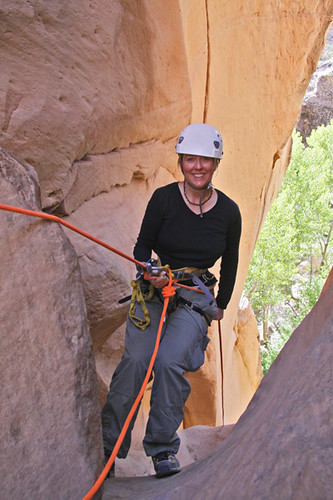 "Just sit back over the ledge," says my guide Greg Istock.
"Just sit back over the ledge," says my guide Greg Istock. I've put my trust in this man, who refers to himself as Mr. Greg, to lead me into a narrow slot canyon in Dixie National Forest near Zion National Park, but the urge to go over the edge of a steep cliff goes against the natural laws that aid human survival. My brain is screaming at me to stop, but my fearless, adventurous side signals green.
"This is your last chance to back out," says Mr. Greg, who guides for Zion Rock and Mountain Guides based in Springdale, Utah. "There's no going back once we're in the canyon."
I gingerly step backwards, held by the rope that would be my lifeline as I lower myself into a shallow entrance to Yankee Doodle Canyon. After a few steps in, the rock wall disappears and I'm free hanging above the ground, which is only 15 feet below. I lower myself down. The next rappel, a drop of nearly 200 feet, came next.
For the next four hours, Istock and I navigate what he calls a technical slot canyon, which means it has several obstacles that require rope for rappels and down climbs, in addition to some knowledge of bouldering maneuvers. In some spots, I must wedge myself between the two walls of the canyon shimmying down until I reach the ground.
In one spot, as my legs dangle freely, I reach under a rock to find something to hold onto. I think of that guy who had to cut off his hand when a rock shifted and rolled onto it. He survived, but only after he sawed his own arm off with a dull pocket knife (I brought a sharp one with me just in case!). Greg had already pointed out a few small loose boulders loosely wedged under an even bigger rock that could easily cause a similar incident. Lucky for me, the only injuries were scrapes and bruises caused by friction burn as bare flesh rubbed against the sandstone.
The last obstacle to get through was a keeper hole. "It's usually full of water and rounded like a bowl," Mr Greg explains. "Worst-case scenario is that we would get into that water and realize we couldn't climb out because it's too slippery on the sides. We'd risk hypothermia because the water is pretty cold and we'd be stuck in there."
Once in the thigh-deep water, I tried in vain many times to flop myself onto the rounded mound separating me from my freedom. I can get out of a swimming pool with no problem, but I kept slipping off the tiny toe hold. Threatening to give me a shove from behind, I made a last-ditch effort to hoist myself over the wall and made it, although Greg assisted by pressing my foot on the toe hold.
I walked confidently out of the canyon into the sunlight, proud of my achievement. It wasn't that hard, I thought. Then I looked up and saw the greatest challenge of all — the steep climb out of the canyon to get back to the car. Huffing and puffing, I dragged myself up the canyon walls, using footholds (called moqui steps) carved out of the sandstone by ancient puebloan people, who called this canyon home more than 500 years ago.
I may not have been the first person to navigate this beautiful canyon, but I felt like an explorer, discovering Utah's underworld for myself.
Sent via BlackBerry from T-Mobile


1 comment:
How awesome! I've never done something like this, but now it's on my “must do” list. Very cool.
Post a Comment